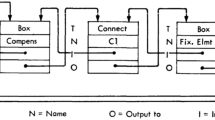Abstract
Within the last two decades digital media have become rapidly absorbed within the diverse fields of design and engineering, which has affected the culture and logic of design and exerted a fundamental impact upon the theories and practices of the various design disciplines. Due to this, there is a need to re-examine and redefine our theoretical foundations and well-accepted models of design in accordance with this major design cultural shift. The main assumption presented here is that the various classes of digital models of design are each diversely changing the role of the visual image in design. These transformations are contributing to new types of synergy between the image and the model of design. Through the systematic formulation, definition, and illustration of the emerging classes and relationships between the visual image and computational processes of design analysis and synthesis in the major models of digital design, this paper defines these emerging new roles of the image as they have diversely evolved in various classes of models of digital design.
Access this chapter
Tax calculation will be finalised at checkout
Purchases are for personal use only
Similar content being viewed by others
Notes
- 1.
For the theory of re-representation see also Annett Karmiloff-Smith (1993).
References
Bohnacker, H., Gross, B., Laub, J., & Lazzeroni, C. (2012). Generative design: Visualize, program, and create with processing. New York: Princeton Architectural Press.
Burry, M., & Murray, Z. (1997). Computer aided architectural design using parametric variation and associative geometry. CAADRIA ‘97, TU Vienna.
Coates, P., & Thum, R. (1995). Generative modelling student workbook. London: University of East London.
Davis, D., Burry, J., & Burry, M. (2011). Understanding visual scripts: Improving collaboration through modular programming. International Journal of Architectural Computing, 10(4), 361–371.
Duarte, J. (2005). A discursive grammar for customizing mass housing: The case of Siza’s houses at Malagueira. Automation in Construction, 14(2), 265–275.
Francescato, G. (1994). Type and the possibility of an architectural scholarship. In K. Franck & L. Schneekloth (Eds.), Ordering space: Types in architecture and design (pp. 253–270). New York: Van Nostrand Reinhold.
Gramazio, F., & Kohler, M. (2008). Digital materiality in architecture. Baden: Lars Müller Publishers.
Gramazio, F., Kohler, M., & Oesterle, S. (2010). Encoding material. In R. Oxman, & R. Oxman (Eds.), The new structuralism: Design, engineering and architectural technologies. Architectural Design, 80(4), 108–115.
Karmiloff-Smith, A. (1993). Constraints on representational change: Evidence from children’s drawing. Cognition, 34, 57–83.
Kolarevic, B. (2003). Architecture in the digital age. New York: Spon Press.
Kolarevic, B., & Malkawi, A. (2005). Performative architecture: Beyond instrumentality. New York: Spon Press.
Lynn, G. (1999). Animate form. New York: Princeton Architectural Press.
Mitchell, W., Liggett, R., & Kvan, T. (1987). The art of computer graphics programming: A structured introduction for architects and designers. New York: Van Nostrand Reinhold.
Oxman, R. (1997). Design by re-representation: A model of visual reasoning in design. In Ö. Akin (Ed.), Special issue on prescriptive and descriptive models of design. Design Studies, 18(4), 329–347.
Oxman, R. (2002). The thinking eye: Visual re-cognition in design emergence. Design Studies, 23(2), 135–164.
Oxman, R. (2006). Theory and design in the first digital age. Design Studies, 27(3), 229–265.
Oxman, R. (2008). Performance-based design: Current practices and research issues. The International Journal of Architectural Computing, 6(1), 1–17.
Oxman, R. (2009). Performative design: A performance model of digital architectural design. Environment and Planning B, Planning and Design, 36(6), 1026–1037.
Oxman, N. (2010a). Structuring materiality. In R. Oxman, & R. Oxman (Eds.), The new structuralism: Design, engineering and architectural technologies. Architectural Design, 80(4), 78–85.
Oxman, R. (2010b). Morphogenesis in the theory and methodology of digital tectonics. Journal of the International Association for Shell and Spatial Structures, 51(3), 195–207.
Oxman, R. (2010c). Informed tectonics in material-based design. The International Journal of Design Studies, 33(5), 427–455.
Oxman, N. (2011). Variable property rapid prototyping. Virtual and Physical Prototyping, 6(1), 3–31.
Oxman, N. (2014). Material ecology. In R. Oxman & R. Oxman (Eds.), Theories of the digital in architecture (pp. 319–326). London/New York: Routledge.
Oxman, R., & Oxman, R. (1992). Refinement and adaptation in design cognition. Design Studies, 13(2), 117–134.
Oxman, R., & Oxman, R. (Eds.). (2010). The new structuralism: Design, engineering and architectural technologies. Architectural Design, 80(4), 108–115.
Oxman, R., & Oxman, R. (Eds.). (2014). Theories of the Digital in Architecture. London/New York: Routledge.
Reas, C., McWilliams, C., & Barendse, J. (2010). Form + code in design, art, and architecture. New York: Princeton Architectural Press.
Schön, D. (1984). The architectural studio as an exemplar of education for reflection-in-action. Journal of Architectural Education, 38(1), 2–9.
Symes, M. (1994). Typological thinking in architectural practice. In K. Franck & L. Schneekloth (Eds.), Ordering space: Types in architecture and design (pp. 165–178). New York: Van Nostrand Reinhold.
Terzidis, K. (2006). Algorithmic architecture. Oxford/Burlington: Architectural Press.
Woodbury, R. (2010). Elements of parametric design. London/New York: Routledge.
Xie, M., Felicetti, P., Tang, J., & Burry, M. (2005). Form-finding for complex structures using evolutionary structural optimization method. Design Studies, 26(1), 55–72.
Author information
Authors and Affiliations
Corresponding author
Editor information
Editors and Affiliations
Rights and permissions
Copyright information
© 2017 Springer International Publishing AG
About this chapter
Cite this chapter
Oxman, R. (2017). The Role of the Image in Digital Design: Processing the Image Versus Imaging the Process. In: Ammon, S., Capdevila-Werning, R. (eds) The Active Image. Philosophy of Engineering and Technology, vol 28. Springer, Cham. https://doi.org/10.1007/978-3-319-56466-1_6
Download citation
DOI: https://doi.org/10.1007/978-3-319-56466-1_6
Published:
Publisher Name: Springer, Cham
Print ISBN: 978-3-319-56465-4
Online ISBN: 978-3-319-56466-1
eBook Packages: Religion and PhilosophyPhilosophy and Religion (R0)




